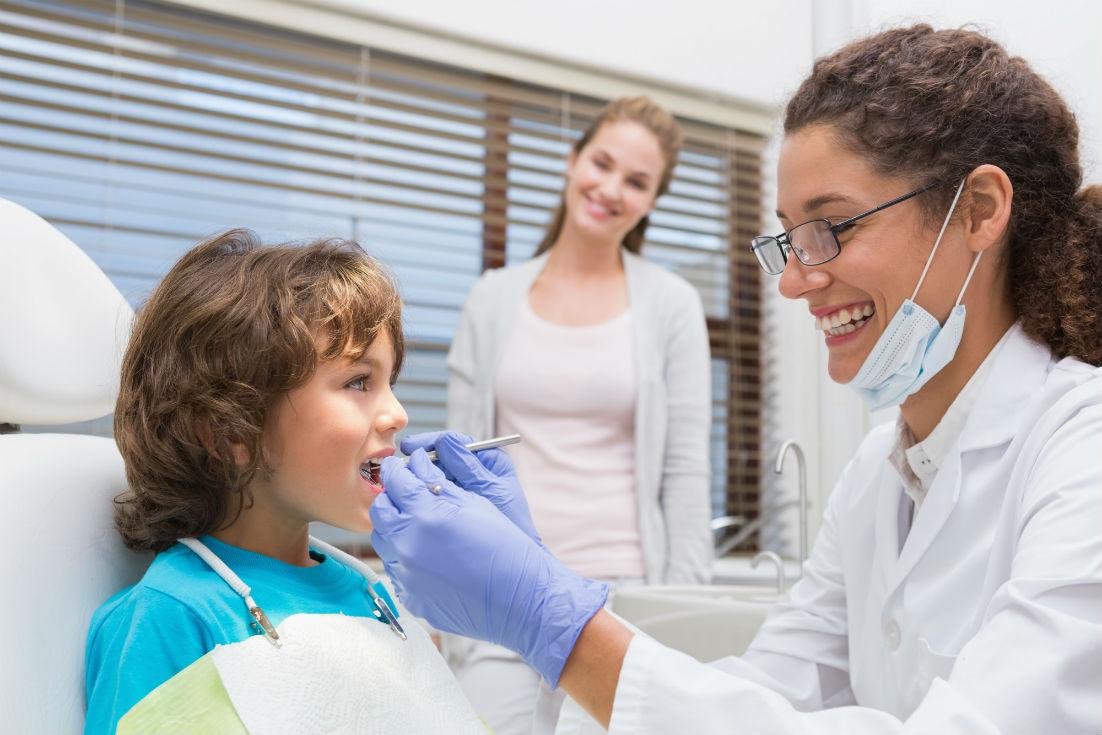Pediatric Dentistry - Woodland Hills, CA
 A child’s first visit to the dentist should be enjoyable. Children are not born with a natural fear of the dentist, but they can fear the unknown. Our office makes a special effort to use pleasant, non-frightening, simple words to describe each treatment. Woodland Hills Dental Care has been recognized as a leading provider of pediatric dentistry in Woodland Hills and the surrounding communities. While most dentists refer their pediatric cases, our dental team is equipped to treat your child’s dental issues directly in our office. With extensive experience in pedodontics, we can provide a true “family” practice where we address the dental needs of your entire family in our Woodland Hills office location.
A child’s first visit to the dentist should be enjoyable. Children are not born with a natural fear of the dentist, but they can fear the unknown. Our office makes a special effort to use pleasant, non-frightening, simple words to describe each treatment. Woodland Hills Dental Care has been recognized as a leading provider of pediatric dentistry in Woodland Hills and the surrounding communities. While most dentists refer their pediatric cases, our dental team is equipped to treat your child’s dental issues directly in our office. With extensive experience in pedodontics, we can provide a true “family” practice where we address the dental needs of your entire family in our Woodland Hills office location.
What Is The Purpose Of Dental Checkups?
First, the pediatric dental team aims to provide a good dental home for the child. If a dental emergency does arise, parents can take the child for treatment at a familiar, comfortable location.
Second, the pediatric dentist keeps meticulous records of the child’s ongoing dental health and jaw development. In general, painful dental conditions do not arise overnight. If the pediatric dentist understands the child’s dental health history, it becomes easier to anticipate future issues and intervene before they arise.
Third, the pediatric dentist is able to educate parents and children during the visit. Sometimes the pediatric dentist wants to introduce one or several factors to enhance tooth health – for example, sealants, fluoride supplements, or xylitol. Other times, the pediatric dentist asks parents to change the child’s dietary or oral behavior – for example, reducing sugar in the child’s diet, removing an intraoral piercing, or even transitioning the child from sippy cups to adult-sized drinking glasses.
Finally, dental X-rays are often the only way to identify tiny cavities in primary (baby) teeth. Though the child may not be feeling any pain, left unchecked, these tiny cavities can rapidly turn into large cavities, tooth decay, and eventually, childhood periodontal disease. Dental X-rays are only used when the pediatric dentist suspects cavities or orthodontic irregularities.
When Is The Best Time To Take Kids To The Dentist?
As soon as your baby’s teeth start they should be examined to ensure that everything is growing properly. The American Dental Association recommends seeing a dentist as soon as they cut their first tooth, and no later than their first birthday. It’s possible for babies to have food trapped in their teeth and develop the same problems as adults.
How Often Should Children Have Dental Checkups
The American Academy of Pediatric Dentists (AAPD) advises parents to make biannual dental appointments for children, beginning approximately six months after the first tooth emerges.
These two important yearly visits allow the pediatric dentist to monitor new developments in the child’s mouth, evaluate changes in the condition of teeth and gums, and continue to advise parents on good oral care strategies.
The pediatric dentist may schedule additional visits for children who are particularly susceptible to tooth decay or who show early signs of orthodontic problems.
Are Checkups Necessary If My Child Has Healthy Teeth?
The condition of a child’s teeth can change fairly rapidly. Even if the child’s teeth were evaluated as healthy just six months prior, changes in diet or oral habits (for example, thumb sucking) can quickly render them vulnerable to decay or misalignment.
In addition to visual examinations, the pediatric dentist provides thorough dental cleanings during each visit. These cleanings eradicate the plaque and debris that can build up between teeth and in other hard to reach places. Though a good home care routine is especially important, these professional cleanings provide an additional tool to keep smiles healthy.
The pediatric dentist is also able to monitor the child’s fluoride levels during routine visits. Oftentimes, a topical fluoride gel or varnish is applied to teeth after the cleaning. Topical fluoride re-mineralizes the teeth and staunches mineral loss, protecting tooth enamel from oral acid attacks. Some children are also given take-home fluoride supplements (especially those residing in areas where fluoride is not routinely added to the community water supply).
Finally, the pediatric dentist may apply dental sealants to the child’s back teeth (molars). This impenetrable liquid plastic substance is brushed onto the molars to seal out harmful debris, bacteria, and acid.
How Can I Prevent Cavities At Home?
Biannual visits with the pediatric dentist are only part of the battle against cavities. Here are some helpful guidelines for cavity prevention:
- Analyze the diet: Too many sugary or starchy snacks can expedite cavity formation. Replace sugary snacks like candy with natural foods where possible, and similarly replace soda with water.
- Cut the snacks: Snacking too frequently can unnecessarily expose teeth to sugars. Save the sugar and starch for mealtimes, when the child is producing more saliva, and drinking water. Make sure they consume enough water to cleanse the teeth.
- Lose the sippy cup: Sippy cups are thought to cause? baby bottle tooth decay? when they are used beyond the intended age (approximately twelve months). The small amount of liquid emitted with each sip causes the sugary liquid to continually swill around the teeth.
- Avoid stickiness: Sticky foods (like toffee) form plaque quickly, and are extremely difficult to pry off the teeth. Avoid them where possible.
- Rinse the pacifier: Oral bacteria can be transmitted from mother or father to baby. Rinse a dirty pacifier with running water as opposed to sucking on it, to avoid contaminating the baby’s mouth.
- Drinks at bedtime: Sending a child to bed with a bottle or sippy cup is bad news. The milk, formula, juice, or sweetened water basically sits on the teeth all night? attacking enamel and maximizing the risk of cavities. Ensure the child has a last drink before bedtime, and then brush the teeth.
- Don’t sweeten the pacifier: Parents sometimes dip pacifiers in honey to calm a cranky child. Do not be tempted to do this. Use a blanket, toy, or hug to calm the child instead.
- Brush and floss: Parents should brush and floss their child’s teeth twice each day until the child reaches the age of seven years old. Before this time, children struggle to brush every area of the mouth effectively.
- Check on fluoride: When used correctly, fluoride can strengthen tooth enamel and help stave off cavities. Too much or too little fluoride can actually harm the teeth, so ask the pediatric dentist for a fluoride assessment.
- Keep to appointments: The child’s first dental visit should be scheduled around his or her first birthday, as per the American Academy of Pediatric Dentistry (AAPD) guidelines. Keep to a regular appointment schedule to create healthy smiles!
Dr. Leila is a painless dentist. Her gentle care practices will put your child at ease. She makes top-quality dental health care easy to attain and a lot of fun!
Learn More About Our Woodland Hills Pediatric Dentistry
Call Us Today to learn more about our pediatric dentistry in Woodland Hills!

